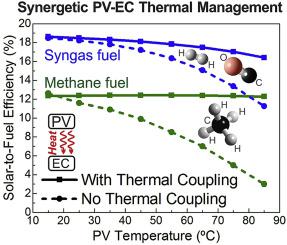Materials Today Energy ( IF 9.0 ) Pub Date : 2020-06-12 , DOI: 10.1016/j.mtener.2020.100425 A.C. Lourenço , A.S. Reis-Machado , E. Fortunato , R. Martins , M.J. Mendes

|
A novel Photovoltaic-Electrochemical (PV-EC) integrated system is designed, capable of converting CO2 into carbon-based fuels, in which “smart” synergetic effects between the two technologies are explored, such as thermal coupling (TC) and electronic regulation (DC-DC), that can strongly improve the energetic performance. We show that, when thermally-coupled, the PV and EC cells exhibit a symbiotic behaviour: the solar-to-fuel efficiency stays almost temperature-independent due to improved reaction kinetics, which compensates for photovoltaic thermal losses. The electronic regulation is equally important, because it guarantees that all power provided by PV generation is channelled to the EC load. When conjugated with TC, the DC-DC converter can boost production up to 50% beyond the TC improvement. For operating temperatures in the 40–90 °C range, combined TC and DC-DC can boost production by up to 586% and 42.9% for Perovskite/Si double-junction and mono-crystalline Si solar cells, respectively. These solutions are tested in two PV-powered pathways for methane production: 1-step, CO2→CH4, and 2-step, CO2→Syngas→CH4; where in the latter the intermediate syngas is converted to methane through catalytic hydrogenation. Despite the advantageous simplicity of the direct production (1-step) of methane, the comparison between the two paths showed that the second route achieves close to 20% higher annual yield.
中文翻译:

阳光驱动的CO 2到燃料的转换:探索光伏和电化学系统之间的热电耦合,以实现最佳的太阳能甲烷生产
设计了一种新颖的光伏-电化学(PV-EC)集成系统,该系统能够转化CO 2进入碳基燃料,其中探索了两种技术之间的“智能”协同效应,例如热耦合(TC)和电子调节(DC-DC),可以极大地提高能量性能。我们表明,当进行热耦合时,PV和EC电池表现出共生的行为:由于改进的反应动力学,太阳能到燃料的效率几乎与温度无关,从而补偿了光伏的热损失。电子调节同样重要,因为它可以确保将光伏发电提供的所有功率都输送到EC负载。与TC结合使用时,DC-DC转换器可将产量提高到TC以外的50%。在40–90°C的工作温度范围内,将TC和DC-DC结合使用可以使产量分别提高586%和42。钙钛矿/硅双结和单晶硅太阳能电池分别占9%。这些解决方案已通过两种以PV供电的甲烷生产途径进行了测试:1步,CO2 →CH 4和2步,CO 2 →合成气→CH 4 ; 在后者中,中间合成气通过催化加氢转化为甲烷。尽管直接生产甲烷(第一步)的优势很简单,但两条路线的比较表明,第二条路线的年产量提高了近20%。











































 京公网安备 11010802027423号
京公网安备 11010802027423号